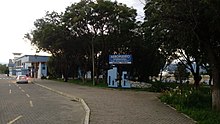Tarija Airport
| Aeropuerto Capitán Oriel Lea Plaza | ||
|---|---|---|
|
|
||
| Characteristics | ||
| ICAO code | SLTJ | |
| IATA code | TJA | |
| Coordinates | ||
| Height above MSL | 1854 m (6083 ft ) | |
| Transport links | ||
| Distance from the city center | 3 km east of Tarija | |
| Local transport | Bus micro A | |
| Basic data | ||
| opening | before 1932 | |
| Terminals | 1 | |
| Start-and runway | ||
| 13/31 | 3050 m × 45 m asphalt | |
The Aeropuerto Capitán Oriel Lea Plaza ( IATA code TJA , ICAO code SLTJ ) is the airport of the southern Bolivian city of Tarija . The airport is used both civilly and militarily. The airport was named on July 20, 1944 in honor of the flight captain Oriel Lea Plaza, who was active in the Chaco War and who had an accident on March 31, 1943 during a training flight with a Curtiss-Wright CW-22 in La Paz.
aims
Only domestic destinations are offered in scheduled air traffic. Direct connections are available with stand in February 2018 to Cochabamba ( Aeropuerto Internacional Jorge Wilstermann ) with Boliviana de Aviación (BoA), according to Santa Cruz de la Sierra ( El Trompillo Airport ) with EcoJet and BoA, and with BoA to La Paz ( El Alto airport ) , Sucre ( Aeropuerto Internacional de Alcantarí ) and Yacuiba ( Aeropuerto Yacuiba ).
Arrival and departure
The airport is enclosed by the urban area and can therefore be easily reached on foot from many areas. Taxis between the airport and the city center cost around 25 Bolivianos (as of 2018) or, depending on the number of people and luggage, around half if you take them outside the terminal, where various microbuses and regular taxis also run.
history
The airport dates from before the Chaco War (between 1932 and 1935, Bolivia and Paraguay fought for the Gran Chaco over oil reserves ). It was one of the first destinations of the then state airline Lloyd Aéreo Boliviano, which was founded in 1925. At that time there were two runways with lengths of 2000 meters and 1220 meters. During the Chaco War, Tarija Airport was an important base for the IV Air Brigade of the Bolivian Air Force . At that time there was no commercial use of the airport.
The expansion of the airport began in 1969 and was completed between 1977 and 1980. The terminal was renovated in the mid-1980s. Since the 2010s, efforts have been made to upgrade the airport so that it can also fly to international destinations on a regular basis. Except for a short-lived connection to Salta in Argentina , nothing has come of it so far (status 2018).
In addition, flying low over large parts of the city area is classified as a safety risk, which is why relocation is discussed again and again. Experts, however, are predominantly of the opinion that the geography of the region does not permit any sensible alternative location.
Incidents
On October 15, 1958 a Douglas DC-3 / C-47A-DL of the TAM - Transporte Aéreo Militar (civil airline of the Bolivian Air Force) ( aircraft registration number TAM-03 ), which was on a charter flight from the Bolivian military base Fortín ( Narciso Campero Province ) to Tarija Airport. It flew into a mountain near Villamontes in Tarija Department . All 20 occupants, including 17 passengers and three crew members, were killed.
Web links
- Airport data on World Aero Data ( 2006 )
- Airport data in the Aviation Safety Network , accessed on November 5, 2013.
- The airport at FlightAware
Individual evidence
- ↑ a b History of the airport on AviaciónBoliviana.Net from December 14, 2009 ( Memento from May 2, 2014 in the Internet Archive ) (Spanish)
- ↑ Direct flights from Tarija on flightmapper.net (English)
- ^ Accident report DC-3 TAM-03 , Aviation Safety Network (English), accessed on August 23, 2020.



